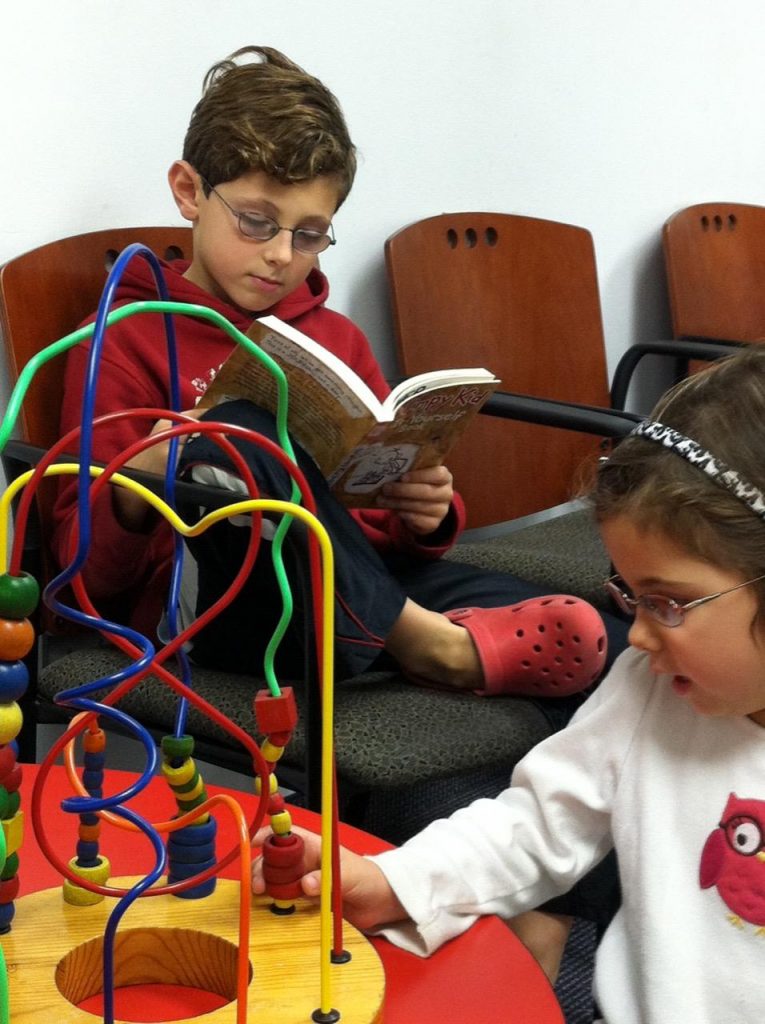The doctor is frequently asked questions about vision “therapy” and eye exercises. Vision therapy refers to a program or series of eye exercises performed in the offices of doctors of optometry. It is touted as an adjunctive treatment for childhood learning disabilities and as a means to improve reading skills. Most referrals to vision therapy programs are made by non-MD’s such as your child’s occupational therapist or well-meaning school counselor. Sessions are typically scheduled 2 to 3 times per week over a period of 12 weeks to the tune of $5000.00. It may not be covered by insurance, and most vision therapists don’t accept insurance anyway. Many of the exercises are performed at the computer where increased screen time is not welcome these days. You won’t be referred for vision therapy by your pediatrician or other medical doctor.

The main flaw in the premise of vision therapy is the false notion that a program of visual stimulation can improve on what nature already gives us. Developmental optometrists are selling you a curriculum purporting to improve eyesight, eye movements and binocular function (the ability to use the eyes together). But seeing is what the eyes do automatically from the moment of birth. No one trains a baby to see or move the eyes. A baby’s ability to fix, follow and converge the eyes by three months of age is amazing. Sometimes the eyes will deviate (strabismus) in the first months of life while a baby is learning how to coordinate eye movements and to use the eyes together. Barring medical eye disease, most children by age 3 years have 20/30 visual acuity and binocular vision has been well established.
Another fallacy of vision therapy is that eye exercises will straighten your child’s eyes and make them work together. This claim is completely false. You cannot exercise eyes into alignment, and, as mentioned above, visual science has shown that binocular vision develops early in life without treatment. No 2-year-old child signs up for vision therapy. Parents and patients need to accept the fact that some types of eye disease or eye misalignment will prevent the development of binocular vision, never to be learned or taught later in life.
Beware of an exhaustive list of diagnoses presented by the developmental optometrist that may include such things as “binocular vision dysfunction, saccadic eye movement disorder, smooth pursuit movement deficiency, and suppression of binocular vision.” If your child really had these things, he or she would not have passed Kindergarten vision screening. Verify any medical diagnoses including visual sensory disorder with a Pediatric Ophthalmologist first as recommended by your pediatrician. As an aside to the learning disabled child referred for vision therapy who may actually have poor binocularity: binocular vision is highly over-rated when it comes to reading. Reading is two dimensional. No depth perception required!
The credibility of those promoting vision therapy is questionable because these doctors presume that the eyes are the culprit in learning disabilities and dyslexia. False hope is given to desperate parents and teachers by blaming the eyes and stating that exercising the eyes will improve reading and other academic skills. Unfortunately, there is way too much emphasis placed on the role of the eyes in learning and reading. As much as we value our eyesight as our greatest sense, we need to face the fact that the eyes are just the messengers to the brain. Straight or misaligned, with glasses or without glasses, monocular or binocular, the eyes just focus images from the page and send them to the brain. It is the brain that interprets and makes use of the information gleaned from the written word. This screams of academics! Logically thinking, how could repetitive eye movements or focusing and converging exercises make your child a better reader? Ask to sit in on a therapy session and see for yourself if you think this will help your child turn the page. Your best bet for your learning disabled child is a reading tutor and lots of practice. Besides, the hours spent on vision therapy and eye exercises could be better enjoyed outdoors engaged in true exercise…
BOTTOM LINE: If vision therapy was free, would you make your child do it?
Parents Take Note of the following Websites:
International Dyslexia Association: (www.dyslexiaida.org)
Learning Disabilities on Line: (www.LDonline.com)
Reading Rockets: (www.readingrockets.org)
References:
From SCIENTIFIC AMERICAN: Volume 256, Number 3, March 1987: “Dyslexia”
“In truth dyslexia seems to be a complex linguistic deficiency. The remedy is proper instruction in reading.”
Conclusion: “We have found that early remediation of reading difficulties is indicated. It should be based on intensive one-to-one tutoring and a balanced reading program… A consensus is emerging among investigators that there is no substitute for direct remedial instruction in reading.”
From PEDIATRICS: Volume 90, Number 1, July 1992:
“Eye defects, subtle or severe, do not cause reversal of letters, words, or numbers. No scientific evidence supports claims that the academic abilities of dyslexic or learning-disabled children can be improved with treatment based on visual training, including muscle exercises, ocular pursuit, tracking exercises, neurological organizational training (laterality training, crawling, balance board, perceptual training or tinted or colored lenses.”
Claims of improvement after visual therapy are “typically based on poorly controlled studies that rely on anecdotal information or testimony.” This article was written by a joint committee of the American Academy of Pediatrics, the American Association for Pediatric Ophthalmology and Strabismus, and the American Academy of Ophthalmology.
